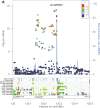Meta-analysis of genome-wide association studies identifies two loci associated with circulating osteoprotegerin levels
- PMID: 25080503
- PMCID: PMC4240210
- DOI: 10.1093/hmg/ddu386
Meta-analysis of genome-wide association studies identifies two loci associated with circulating osteoprotegerin levels
Abstract
Osteoprotegerin (OPG) is involved in bone homeostasis and tumor cell survival. Circulating OPG levels are also important biomarkers of various clinical traits, such as cancers and atherosclerosis. OPG levels were measured in serum or in plasma. In a meta-analysis of genome-wide association studies in up to 10 336 individuals from European and Asian origin, we discovered that variants >100 kb upstream of the TNFRSF11B gene encoding OPG and another new locus on chromosome 17q11.2 were significantly associated with OPG variation. We also identified a suggestive locus on chromosome 14q21.2 associated with the trait. Moreover, we estimated that over half of the heritability of OPG levels could be explained by all variants examined in our study. Our findings provide further insight into the genetic regulation of circulating OPG levels.
© The Author 2014. Published by Oxford University Press. All rights reserved. For Permissions, please email: journals.permissions@oup.com.
Figures





Similar articles
-
A New Measure of Quantified Social Health Is Associated With Levels of Discomfort, Capability, and Mental and General Health Among Patients Seeking Musculoskeletal Specialty Care.Clin Orthop Relat Res. 2025 Apr 1;483(4):647-663. doi: 10.1097/CORR.0000000000003394. Epub 2025 Feb 5. Clin Orthop Relat Res. 2025. PMID: 39915110
-
Systemic pharmacological treatments for chronic plaque psoriasis: a network meta-analysis.Cochrane Database Syst Rev. 2017 Dec 22;12(12):CD011535. doi: 10.1002/14651858.CD011535.pub2. Cochrane Database Syst Rev. 2017. Update in: Cochrane Database Syst Rev. 2020 Jan 9;1:CD011535. doi: 10.1002/14651858.CD011535.pub3. PMID: 29271481 Free PMC article. Updated.
-
Meta-analysis of GWAS of over 16,000 individuals with autism spectrum disorder highlights a novel locus at 10q24.32 and a significant overlap with schizophrenia.Mol Autism. 2017 May 22;8:21. doi: 10.1186/s13229-017-0137-9. eCollection 2017. Mol Autism. 2017. PMID: 28540026 Free PMC article.
-
Systemic pharmacological treatments for chronic plaque psoriasis: a network meta-analysis.Cochrane Database Syst Rev. 2021 Apr 19;4(4):CD011535. doi: 10.1002/14651858.CD011535.pub4. Cochrane Database Syst Rev. 2021. Update in: Cochrane Database Syst Rev. 2022 May 23;5:CD011535. doi: 10.1002/14651858.CD011535.pub5. PMID: 33871055 Free PMC article. Updated.
-
Systemic pharmacological treatments for chronic plaque psoriasis: a network meta-analysis.Cochrane Database Syst Rev. 2020 Jan 9;1(1):CD011535. doi: 10.1002/14651858.CD011535.pub3. Cochrane Database Syst Rev. 2020. Update in: Cochrane Database Syst Rev. 2021 Apr 19;4:CD011535. doi: 10.1002/14651858.CD011535.pub4. PMID: 31917873 Free PMC article. Updated.
Cited by
-
Osteoprotegerin rich tumor microenvironment: implications in breast cancer.Oncotarget. 2016 Jul 5;7(27):42777-42791. doi: 10.18632/oncotarget.8658. Oncotarget. 2016. PMID: 27072583 Free PMC article. Review.
-
Osteoprotegerin SNP associations with coronary artery disease and ischemic stroke risk: a meta-analysis.Biosci Rep. 2020 Oct 30;40(10):BSR20202156. doi: 10.1042/BSR20202156. Biosci Rep. 2020. PMID: 32955093 Free PMC article.
-
Osteoprotegerin concentration and risk of cardiovascular outcomes in nine general population studies: Literature-based meta-analysis involving 26,442 participants.PLoS One. 2017 Aug 24;12(8):e0183910. doi: 10.1371/journal.pone.0183910. eCollection 2017. PLoS One. 2017. PMID: 28837646 Free PMC article.
-
Single-cell sequencing systematically analyzed the mechanism of Emdogain on the restoration of delayed replantation periodontal membrane.Int J Oral Sci. 2025 Apr 17;17(1):33. doi: 10.1038/s41368-024-00345-5. Int J Oral Sci. 2025. PMID: 40246878 Free PMC article.
-
Delineating the role of osteoprotegerin as a marker of breast cancer risk among women with a BRCA1 mutation.Hered Cancer Clin Pract. 2022 Apr 13;20(1):14. doi: 10.1186/s13053-022-00223-3. Hered Cancer Clin Pract. 2022. PMID: 35418083 Free PMC article. Review.
References
-
- Schoppet M., Preissner K.T., Hofbauer L.C. RANK ligand and osteoprotegerin – paracrine regulators of bone metabolism and vascular function. Arterioscl. Throm. Vas. 2002;22:549–553. - PubMed
-
- Yun T.J., Chaudhary P.M., Shu G.L., Frazer J.K., Ewings M.K., Schwartz S.M., Pascual V., Hood L.E., Clark E.A. OPG/FDCR-1, a TNF receptor family member, is expressed in lymphoid cells and is up-regulated by ligating CD40. J. Immunol. 1998;161:6113–6121. - PubMed
-
- Tan K.B., Harrop J., Reddy M., Young P., Terrett J., Emery J., Moore G., Truneh A. Characterization of a novel TNF-like ligand and recently described TNF ligand and TNF receptor superfamily genes and their constitutive and inducible expression in hematopoietic and non-hematopoietic cells. Gene. 1997;204:35–46. - PubMed
-
- Simonet W.S., Lacey D.L., Dunstan C.R., Kelley M., Chang M.S., Luthy R., Nguyen H.Q., Wooden S., Bennett L., Boone T., et al. Osteoprotegerin: A novel secreted protein involved in the regulation of bone density. Cell. 1997;89:309–319. - PubMed
Publication types
MeSH terms
Substances
Grants and funding
- 2R01HL092577/HL/NHLBI NIH HHS/United States
- P30 CA015704/CA/NCI NIH HHS/United States
- R01 HL092577/HL/NHLBI NIH HHS/United States
- R01 HL076784/HL/NHLBI NIH HHS/United States
- U01GM092655/GM/NIGMS NIH HHS/United States
- U54RR0024384/RR/NCRR NIH HHS/United States
- R01AR/AG 41398/AG/NIA NIH HHS/United States
- N01 HC025195/HL/NHLBI NIH HHS/United States
- R01 AG028321/AG/NIA NIH HHS/United States
- U01 GM092655/GM/NIGMS NIH HHS/United States
- N02-HL-6-4278/HL/NHLBI NIH HHS/United States
- N01-HC-25195/HC/NHLBI NIH HHS/United States
- R01HL076784/HL/NHLBI NIH HHS/United States
- R01 AR041398/AR/NIAMS NIH HHS/United States
- 1R01HL64753/HL/NHLBI NIH HHS/United States
- 1 R01AG028321/AG/NIA NIH HHS/United States
LinkOut - more resources
Full Text Sources
Other Literature Sources

